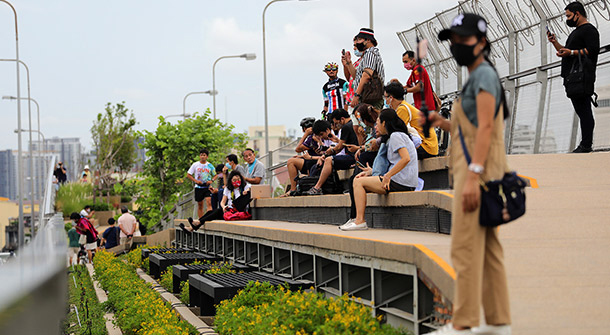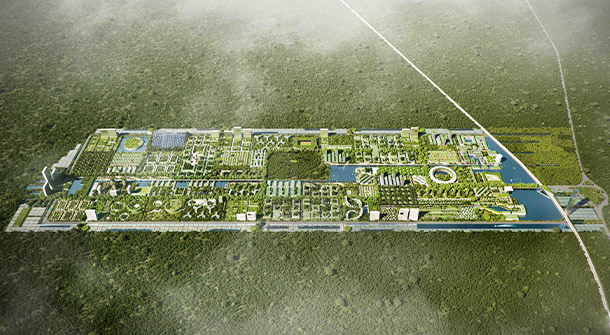Toward a better urban future
In the run up to World Architecture Day, we asked some of our team to share an initiative they admire or feel passionate about – something that identifies with this year’s message about how urban planning, architecture and design can lead us all “Toward a better urban future”.
From prefabricated buildings and an urban ecosystem to visual impairment, New Towns and a garden bridge, here’s a snippet of their musings.
Pedestrian facilities for people with visual impairment
When Sara Tobalina del Val was studying architecture, she was drawn to urban planning. “I remember becoming really obsessed with Google Earth and trying to draw the perfect scale of pavements for small urban developments. It was then that I started to learn about the global community’s agreed strategies to assist people with visual impairment in the pedestrian environment.

Image pixabay
“There are numerous wayfinding strategies in the urban scale that we don’t pay attention to when walking around towns and cities, but they’re very clever. For example, the blister-like bumps, also known as ‘truncated domes and detectible warning pavers’ are a part of what’s known as ‘tactile paving’ – paving that can be felt. These surface indicators can be found at railway and underground stations, stairs, crossings etc. Different contrasts in texture provide different messages. To find out more about the little-known (yet very important) language of our pavements, check out this post on the RNIB website.”
Prefabricated buildings
For designer Seraphina Gogate, it’s all about prefab buildings. “A better Urban Future involves a strong push for equality from the consumer market, legislative bodies, and the construction industry alike. It makes use of emerging technologies like AI or machine learning to inform current design processes and contextualises its definition of creativity within problem-solving rather than trendsetting.
“Prefabricated buildings represent an opportunity in the long run for sustainable reform and narrowing the gaps caused by socio-economic difference. In the short run, prefab buildings can help with the current crisis in a facile manner by reducing the need to have masses of people on construction sites. Even before the pandemic, prefab buildings were widely considered safer to build as they’re constructed in ‘laboratory’ conditions.

Image credit: Dezeen
“The criticisms of prefab are that it isn’t site-specific (although I think that with the use of AI and smarter, more sensitive designers, we can overcome this problem) and that it will lead to job losses throughout the construction world, an expected eventuality with the introduction of new tech.
“I concede that prefab doesn’t have a place everywhere; it cannot be used as yet for buildings that need a sense of character that distinguishes them – stately buildings, flagship stores or parliament houses – but it can be used to put out affordable housing or centres of education that have a low cost, small environmental impact and could benefit from the use of more au courant technology.”
For further reading, here’s a listing of prefabricated buildings in Dezeen and an article from the World Economic Forum.
Chao Phraya Sky Park, Bangkok
Opened in June 2020, this 280-metre, accessible-to-all garden bridge crosses the city’s Chao Phraya River. For Spencer Baxter, our Bangkok-based Director, “The sky park provides Bangkokians with a green pedestrian walkway to not only travel from one side of the river to the other but to also enjoy as leisure space – there are 360-degree views across the city. The structure had been derelict for over 30 years – it was part of the city’s unsuccessful skytrain project, which provided the base structure for the raised park.

Image credit: The Standard
“The scheme was developed by the Department of City Planning and Urban Development, Bangkok Metropolitan Administration (BMA) and is a small-scale example of how an abandoned area can be overhauled to improve the quality of life for urban residents and benefit the environment, in a city that’s severely lacking in accessible green space.”
Rêveries Urbaines (Urban Daydreaming) – Bouroullec Brothers
For Alison Smith, over at Nulty Bespoke, this architectural concept from a while back – about the interaction of nature and urban environment – resonated because of her progression from suburban roots to the city, and the lack of/ desire for outdoor space, greenery and calmness that she’d been used to.
“As part of our human needs we require stimulation from nature, which is something we lack in the urban environment. Creating pockets and platforms of nature or structures that hold natural matter provide larger areas of space and beauty, an irony of building manmade natural environments upon the built environment, that once was mother nature’s land, starts to emerge.

Image credit: Dezeen
“The conceptual work by the Bouroullec brothers is somewhat on point in current times, showing just how apparent our desires are from assessing human behaviour during the coronavirus and how many are escaping to the suburban areas to explore the outdoors, as a necessity for both their physical and mental wellbeing.”
Find out more in this Dezeen article and video from Ronan & Erwan Bouroullec.
Smart Forest City, Cancun
The concept for this pioneering, eco-efficient urban project in Mexico is something that captured the attention of our designer, Jessica Munaf. The proposed forested site, based on Mayan heritage, will cover 557 hectares, house a population of up 130,000 and operate a circular economy.
“All of us are (or should be) familiar with the four Rs – reduce, reuse, recycle and recover – for sustainable living. The problem is, not many of us fully implement them in our way of life.

Image credit: The Big Picture
“I believe in a theory of organic architecture that respects and promotes harmony between human habitation and the natural world through design approaches – where building and surrounding merge to become one. The Smart Forest City near Cancun, Mexico, designed by Stefano Boeri Architetti, will be an interesting project to keep watch on because it proposes to redefine urban living through impressive environmental and technological credentials. Will settlements like this, where city and nature combine, create a new and better urban future? I for one hope so.”
Find out more about this pioneering project here.
New Towns: The Rise, Fall and Rebirth
This recently published book by Katy Lock and Hugh Ellis has been suggested by our Managing Director, Ellie Coombs. What can we learn from the UK’s post-war New Towns to determine a better urban future for all? Here’s the synopsis…
“Often misunderstood, the New Towns story is a fascinating one of anarchists, artists, visionaries, and the promise of a new beginning for millions of people. New Towns: The Rise Fall and Rebirth offers a new perspective on the New Towns Record and uses case-studies to address the myths and realities of the programme. It provides valuable lessons for the growth and renewal of the existing New Towns and post-war housing estates and town centres, including recommendations for practitioners, politicians and communities interested in the renewal of existing New Towns and the creation of new communities for the 21st century.” The book is available to purchase here.

Banner image pixabay


